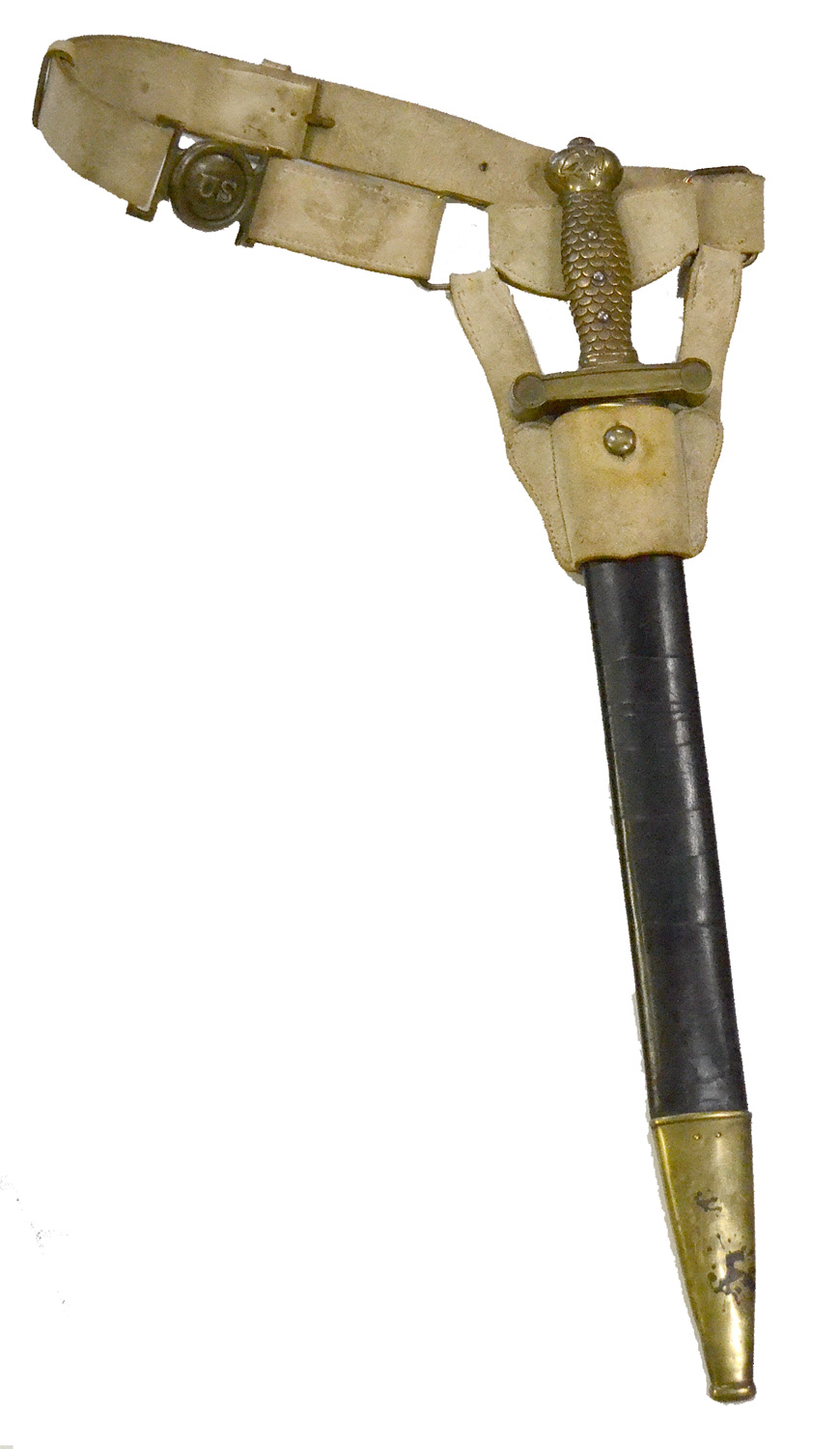site search
online catalog
VERY NICE US 1832 PATTERN SWORT SWORD DATED 1835 AND REGULATION 1839 PATTERN BELT

$3,200.00
Quantity Available: 1
Item Code: 1052-42
Shipping: Determined by Method & Location of buyer
To Order:
Call 717-334-0347,
Fax 717-334-5016, or E-mail
This is a really nice example of the U.S. artillery short sword and belt. Adopted by the army in 1832, this gladius-pattern short sword was a big seller for Ames to the U.S. and state governments, militia groups, and even some fraternal organizations. Initially intended also for NCOs and musicians, it became the side arm for just foot or heavy artillery when the 1840 patterns were issued. This is dated 1835 and is likely one of 2,400 made on a November 1834 contract (all delivered by late June 1835) or from a group of 400 contracted for in February 1835 and delivered in December. In either case it dates to the period of the Alamo and the Second Seminole War, in the latter of which US regular artillerymen served as infantry.
The brass hilt has no dents or serious dings and still has traces of gilt on the underside of the guard. The eagle on the pommel faces is well rendered and detailed. (Thillmann, p.43, illustrates two examples from 1835, showing how the quality of finish and detail can vary even in one year.) The blade markings show wear from cleanings over the years, but the result is that the blade is has no pitting and is smooth metal, with largely bright finish, just a few gray spots, and good edge and point. One ricasso is marked UNITED / STATES / 1835 / JM with some rubbing on the right of the top two lines. The other side shows traces of the eagle’s right wing and the right few letters of N.P. Ames / Springfield. The inspection stamps on the underside of the guard, however, are very legible: “JM,” matching the Justin Murphy blade inspection stamp, “ORD.” and the “H.K.C.” of Henry Knox Craig.
The scabbard is the regulation pattern with black leather body and gilt brass throat with fastening stud, and drag. The leather has good color and surface with some cracking to the finish from age, but no bends, breaks or losses, and the seam is very good. The drag shows some dings and darker spots on the obverse, but is secure.
The white buff belt is in super condition, complete, and flexible. The belt buckle is the two-piece interlocking U.S. introduced in 1839 and used on the 1840 pattern light and heavy artillery sword belts. The buff is a pleasant, mellow cream color with some dust and dirt and a few thin stains, but nothing obtrusive. The frog, arms, loops, and adjusting hook are there. The central belt element, where the hilt of the sword rests against it, has some pulled threads on the reverse vertical seam, but is perfectly stable. The color of the sword hilt and buckle match very well.
This is a nice example of a regulation, early US enlisted sword and belt dating to the US westward expansion. It would fit a US edged weapons, Mexican War, or antebellum army collection. It would also fit the early Civil War. The regular army had gone to black buff and the 1851 belt plate by then, but lots of earlier equipment was issued by necessity to equip the suddenly expanded army. [sr] [ph:L]
~~~~~~~~~~~~~~~~~~~~~~~~~~~~~~~~~~~
THIS ITEM, AS WITH ALL OTHER ITEMS AVAILABLE ON OUR WEB SITE,
MAY BE PURCHASED THROUGH OUR LAYAWAY PROGRAM.
FOR OUR POLICIES AND TERMS,
CLICK ON ‘CONTACT US’ AT THE TOP OF ANY PAGE ON THE SITE,
THEN ON ‘LAYAWAY POLICY’.
THANK YOU!
Inquire About VERY NICE US 1832 PATTERN SWORT SWORD DATED 1835 AND REGULATION 1839 PATTERN BELT
For inquiries, please email us at [email protected]
Most Popular
Historical Firearms Stolen From The National Civil War Museum In Harrisburg, Pa »
Theft From Gravesite Of Gen. John Reynolds »
Selection Of Unframed Prints By Don Troiani »
Fine Condition Brass Infantry Bugle Insignia »
British Imported, Confederate Used Bayonet »
Scarce New Model 1865 Sharps Still In Percussion Near Factory New »
featured item
DAGUERROTYPE IN UNIFORM OF LEWIS HENRY LITTLE, BREVET FOR GALLANT AND MERITORIOUS CONDUCT AT MONTEREY 1846; KILLED IN ACTION AS CONFEDERATE BRIGADIER GENERAL AND DIVISION COMMANDER AT IUKA 1862
This very clear sixth-plate daguerreotype dates about 1850 and shows Lewis Henry Little, usually referred to by his middle name, as a Captain in the 7th U.S. Infantry. Born in Maryland in 1817, he was appointed 2nd Lieutenant in the 5th US Infantry… (1138-1808). Learn More »
site search
Upcoming Events
May 16 - 18: N-SSA Spring Nationals, Fort Shenandoah, Winchester, VA Learn More »
























